Friday, April 6th 2012
The weekend has come early this week because of Easter. Finding ourselves free today, Friday, we thought we would betake ourselves to Kentish Town for breakfast as we hadn't been there for a while.
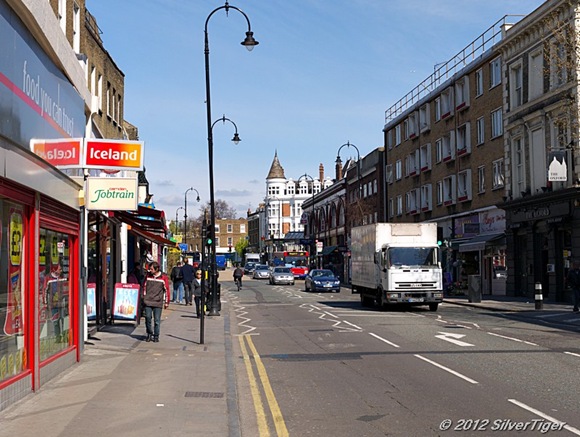
Kentish Town Road
The turret belongs to the Assembly House pub
In Kentish Town, we usually go for breakfast to Cafe Renoir, a French-style cafe in Kentish Town Road, near the station.
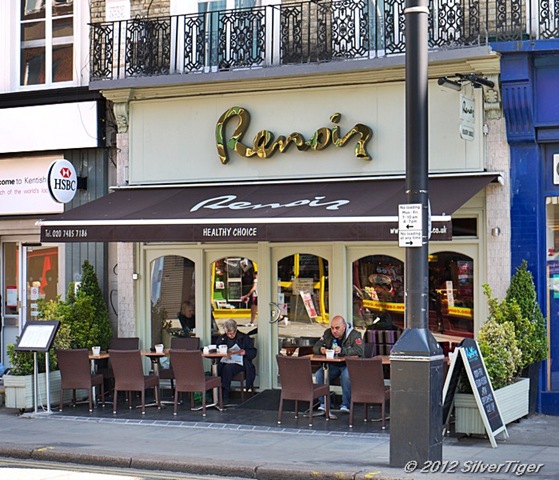
Cafe Renoir
A French-style cafe in Kentish Town
The main part of the cafe was quite busy so we found a comfortable table in the back room.
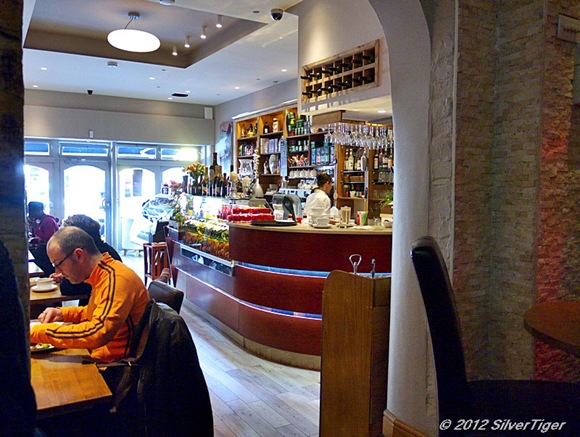
View from the back room
We found a comfortable table
Though the cafe looks superficially French, the management is not French, but there is a varied menu and the service is amiable.
The cafe also participates in Camden's Public and Community Toilets scheme whereby cafes, pubs and other establishments allow their toilets to be used by members of the public without their being customers of the establishment concerned. This strikes me as a welcome initiative to combat the scandalous shortage of public toilets in London. So far, though, very few businesses have signed up for the scheme, which I think is understandable. More credit therefore goes to those that do decide to participate.
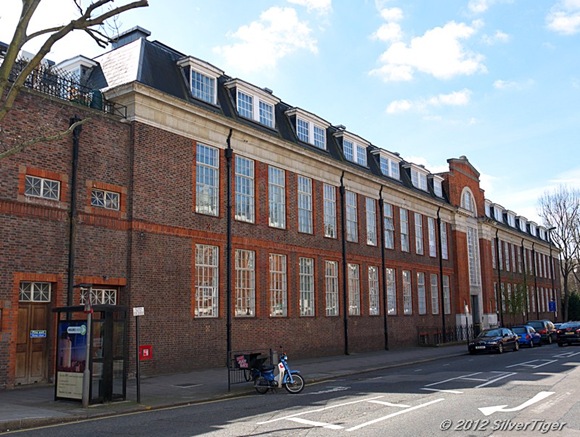
No 1 Prince of Wales Road
A building with a hidden history
On the corner of Prince of Wales Road with Kentish Town Road stands this building, today referred to as "No 1 Prince of Wales Road". It is an apartment block now, with a PizzaExpress restaurant occupying one corner. However, its history is more interesting than this but I know only a small part of it. My involvement with the building is that I used to work here when it was known as the North-Western Polytechnic, one of a group of about 30 institutes of further and higher education in the UK.
Later, the government reorganized the polytechnics and the North-Western combined with the Northern Polytechnic to form the Polytechnic of North London. This building was one of the latter's precincts, housing humanities departments and the School of Teaching Studies. In due course, the government changed things again and the Polytechnic became the University of North London. By then I had left the world of education and was enjoying myself working in bookshops and libraries. At some point, the Kentish Building was deemed surplus to requirements by what became (in yet another change) the London Metropolitan University, and was sold off.
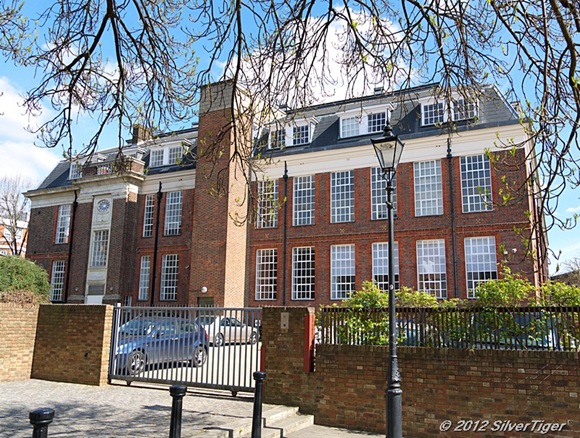
No 1 Prince of Wales Road
View from the side
That, as you might guess from the age of the building, was not its entire history by any means. Unfortunately, I know little of that history and would like to know more. I believe it was an educational institution in the early 20th century and was used as a military hospital during one of Britain's wars, though I do not know which one. My evidence for it being a school or college is the lettering over the side door, which you can just about see on the left in the above photo. Someone has chiselled out the top line, leaving just the word "ENTRANCE", but it used to read "WOMENS’ ENTRANCE", arguing that this was once a mixed-gender institution of some sort, perhaps in Edwardian or even Victorian times.

A listed building
But perhaps not the one you think
In this photo there is a listed building - but which one? Right next to the old poly building stands the Hope Chapel, dated 1871. It is quite familiar to me from working nearby but I rarely saw any activity within or around it. So, which is the listed building building? If you said "The chapel", that was a reasonable choice, but wrong. The listed building is the K2 telephone kiosk standing beside it. As far as I know, neither No 1 nor Hope Chapel are listed.
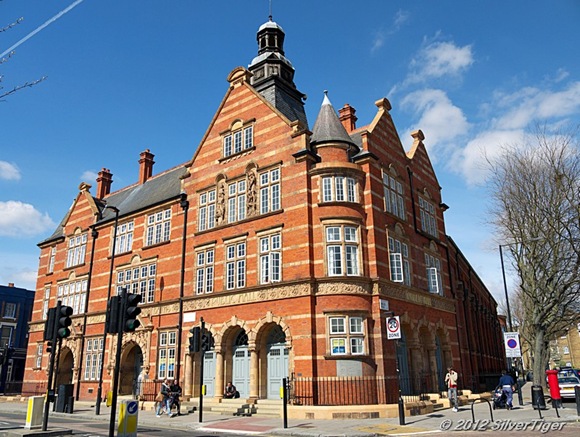
Kentish Town Baths
Rescued from demolition
Almost opposite the Hope Chapel is this rather fine piece of late Victorian architecture. the Kentish Town public baths. Many inhabitants of Kentish Town remember when this establishment still functioned according to its original purpose but times change and the once much used building came under threat of demolition so that the site could be "developed" - an all too familiar scenario.
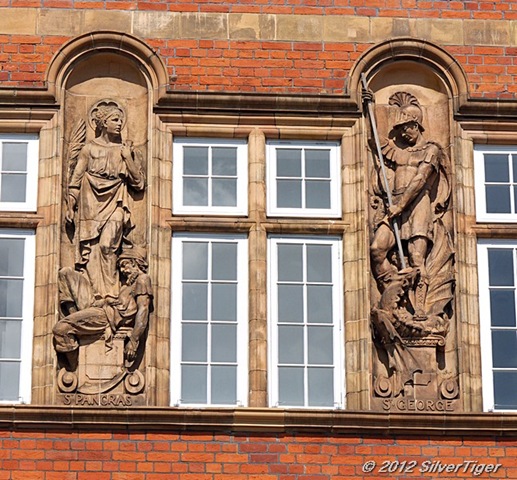
Patron saints
Saint Pancras and Saint Christopher
The foundation stone was laid on May 17th 1900, just within the late Victorian period. On the façade appear two patron saints, Saints Christopher and Pancras. I am not sure of the role of Christopher here (though he does seem to be given quite a lot of patronage jobs) but the significance of St Pancras is more obvious: when the baths were built, the area was in the control of the Vestry of St Pancras.
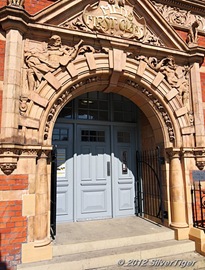
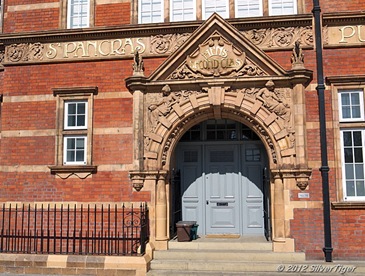
Men's entrances to the baths
Victorian class consciousness required first and second class facilities
Fortunately, this beautiful building was able to be saved, refurbished and "repurposed" as a sports centre. On a bright sunny day like today, it positively smiles at you with its clean red brickwork and glistening gilt lettering. Men had two entrances, first and second class, respectively, and received a different standard of service accordingly. Note the beautiful carving around the doorways.
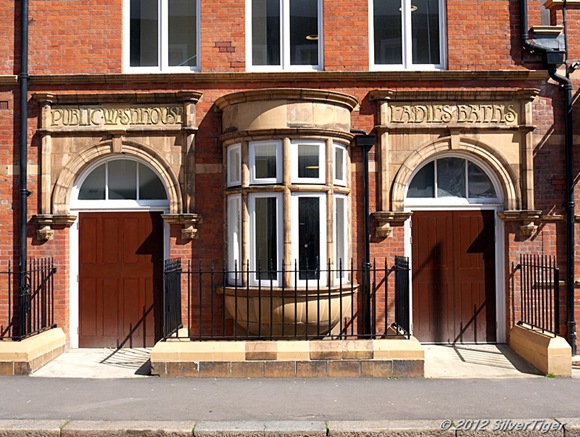
Ladies' Entrance and Public Washhouse
A discreet if less salubrious entrance for the ladies
Where the ladies were concerned, there was less panache. Their entrance - they had only one class for all - was small, discreet, and tucked away around the corner in Grafton Road. Their door was next to the Public Washhouse, where they would no doubt encounter women of the lower classes.
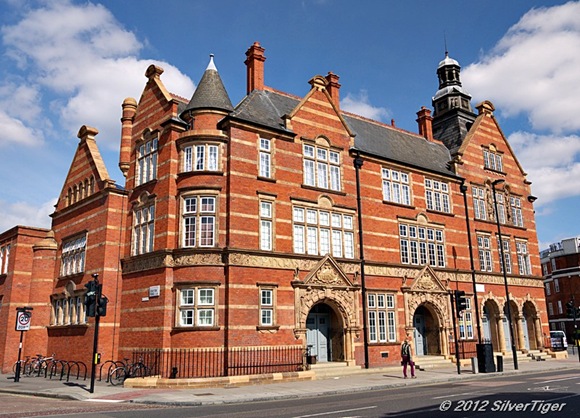
The exterior remains as it was
The interior has changed beyond recognition
After a lot of restoration work and an expenditure of more than £25m, the exterior of the building looks much as it would have done when it was first built but the interior has changed beyond recognition with gymnasia and swimming pools. Its mode of use has been democratized and the sports centre is open to all who are ready to pay the entrance fee or take out a membership.
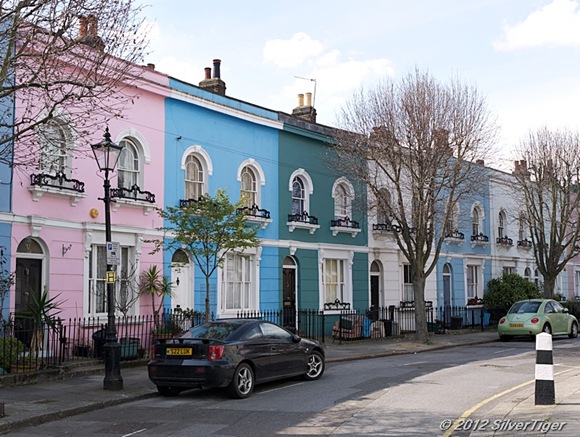
Kelly Street
Colourful façades
Around the corner from what I still think of as the old poly building, is Kelly Street, a curving street where you will find a fine set of mid-19th century houses, the odd-numbered members of which are Grade II listed. In a rare show of communal unanimity, all of the façades have been pointed in light pastel shades, which Tigger calls "ice cream colours". What could have been a disaster actually works very well and the colours light up the street and prettify it, lending to it a feeling of the seaside or a Mediterranean village. This street is unique in this corner of Kentish Town.
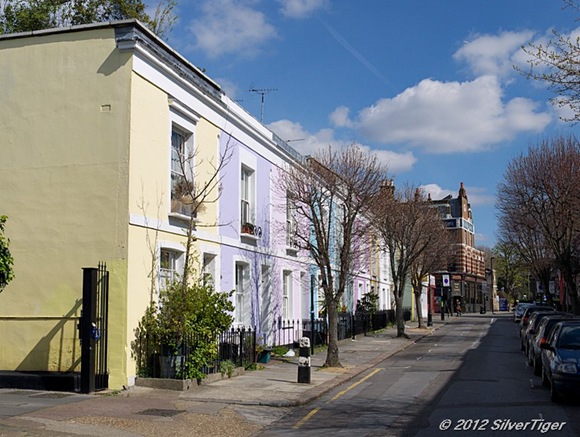
Abbey Tavern from Kelly Street
A glimpse of a pub of renown
Looking along Kelly Street, we can glimpse the fetching red and white façade of the Abbey Tavern on Kentish Town Road. It is a pub that wears its history lightly and seems to be confronting the future with confidence.

Abbey Tavern
Changing with the times
The Abbey Tavern dates from mid-Victorian times and I am guessing that what is today the beer garden was once a yard where horses came in. Possibly it was a hotel as well, as its height suggests. I have to admit an interest here, namely that in my days as a polytechnic teacher I spent many hours here. The Abbey was our unofficial staff room, so to speak, and perhaps also an unofficial students' union. Down the road was a Dunn's hat works (now gone) from where gentleman in smart suits and sharp hats would come for lingering lunches. It was run by an Irish couple and the bar staff were also Irish. Great times.
Today, we went in, as much to snoop around as anything. The outside remains the same, give or take a coat of paint, but the interior has been remodelled. To judge by the atmosphere, the pub has hit the right note and is facing the present and future with a confidence that not all pubs can muster these days. If there are ghosts, they are discrete enough to stay out of sight during opening hours.
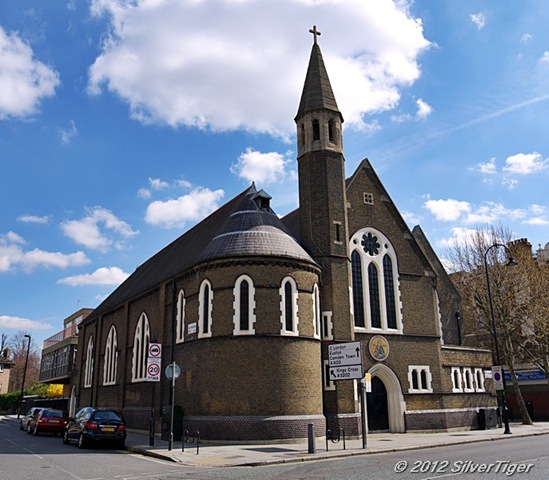
St Andrew's
Greek Orthodox Cathedral
On the adjacent corner to the Abbey, stands St Andrew's. Built in 1884-5 and originally known as the Anglican church of St Barnabas, the building was passed to the Greek Orthodox Church and renamed St Andrew's. In 1970, its status was raised to that of a Cathedral and in 1999 it became Grade II listed. It quietly reminds us that this part of London has seen many waves of immigration through the centuries and has offered itself as a refuge and home to folk from foreign lands fleeing oppression and disasters. They have all left their mark, some more noticeably than others, and added to the texture of the area.

Decorative panel, Kentish Town Baths
Copyright © 2012 SilverTiger, http://tigergrowl.wordpress.com, All rights reserved.
















